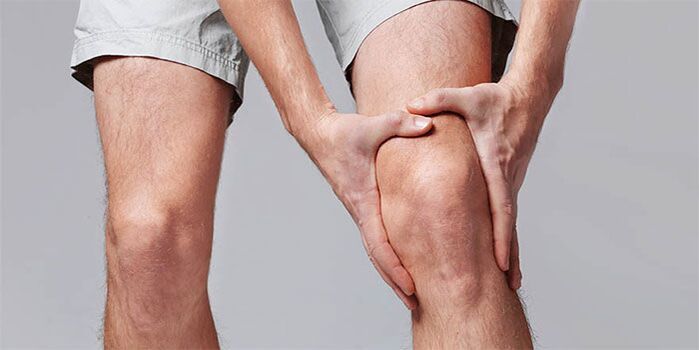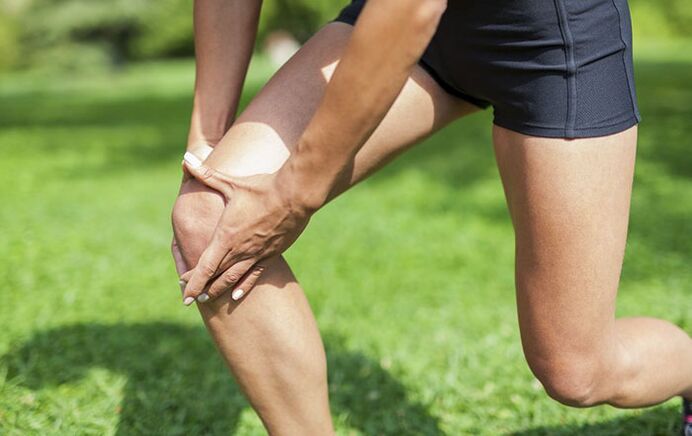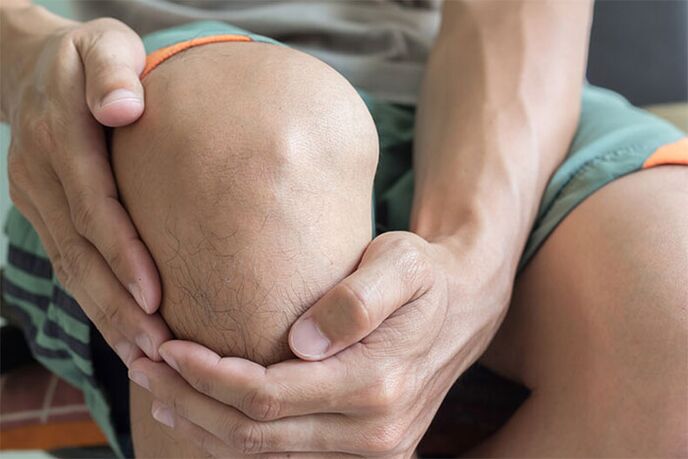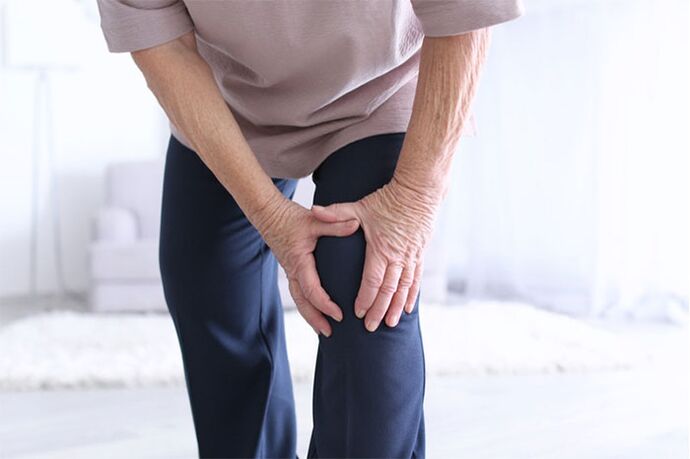
Everyone experiences knee pain from time to time. This may be the result of a sudden movement or a symptom of an active disease. The knee joint is the largest and anatomically complex element of the musculoskeletal system. It accounts for up to 80% of body weight, leading to increased physical performance and increased risk of injury. A large number of capillaries, nerve fibers, and muscle tissue make any injury, no matter how small, extremely painful. Injured nerves cause an inflammatory process, accompanied by swelling, skin discoloration and increased local temperature.
As the process progresses, the joints themselves, the fluid in the joints and the connective tissues are pulled into a pathological state, which can have serious consequences - the development of joint diseases. A general understanding of the anatomical structure of the knee joint will help you understand what factors may be causing the pain, and what steps should be taken to eliminate the pain.
Anatomical structure
The anterior region of the joint is formed by the kneecap, in simpler words - the kneecap. It is connected to the quadriceps (lensional) muscle, continues in the stellate ligament, and collectively, forms a ligamentous apparatus, which includes the following muscle types:
- Lateral branches from tibia (small and large);
- back support buttons - sickle, in the back, in the middle and on the side;
- transverse and cruciate ligaments of the knee.
The anterior cruciate ligaments are most susceptible to injury - vigorous movements, large rotations, falls with compression of the posterior cruciate ligaments lead to rupture of the intervertebral joints.
Ligaments are divided into two types:
- Anterior - they have the function of stabilizing the ankle joint, in particular, preventing excessive forward displacement. They arise from the posterior aspect of the great femur, intersect the posterior cruciate ligaments in the compartment of the knee, and attach to the groove between the anterior condyle of the tibia.
- Rear - restricts lower leg from moving back. They begin at the anterior superior portion of the femur, pass through the joint cavity, and end between the posterior condyle of the tibia.
On the surface of the joints is cartilage. At the junction of the tibia and femur, there are meniscuses - a type of joint lining that acts as a shock absorber and stabilizer.
There are several synovial sacs (three to five) in the knee joint that provide natural lubrication:
- above the kneecap;
- popliteal worm;
- between the tendons in the long thigh muscle;
- subcutaneous patella;
- in the depression below the knee joint.
Thanks to the knee, a person can step, flex, and extend within the specified limits of the ligament.

Cause of pain
Inflammation can develop in the following structures:
- cartilage;
- general cover;
- joint translation;
- tibia;
- muscles and tendons that surround joints;
- ligament apparatus;
- blood vessels, veins, arteries;
- subcutaneous fat;
- cuticle.
The most common causes of knee pain are:
- Osteoarthritis is the cause of more than 50% of knee pain cases. It is characterized by the gradual destruction of hyalinized cartilage. For a long time, it may be asymptomatic and aggravated in the second stage. Knee pain occurs due to the growth of bone cells affecting the nerves;
- Arthritis is an acute inflammatory disease. It can be an independent disease - spondylitis or a complication of other joint pathologies - arthropathy, rheumatic disease, etc. v. Arthritis is characterized by severe pain, accompanied by swelling and redness;
- Osteoarthritis - joint cartilage becomes inflamed over time accompanied by osteoarthritis, mechanical trauma;
- Periarthritis is a disease that occurs on the basis of obesity (usually occurs in women). The disease affects the tendons and muscles and then moves to the sheath of the knee joint. Moderate pain, pulling (as in a sprain).
- Chondromatosis is the formation of nodes in the hyaline cartilage tissue, eventually spreading throughout the knee capsule. In this case, compression of the soft tissues occurs with a large number of nerve cells. As a result, the knee is in constant pain, even during rest.
- Bursitis - the bursa of the knee joint is rarely self-inflammatory, only due to trauma or complications of minor joint diseases, thereby causing pain.
- Cellulite - subcutaneous adipose tissue can cause pain only in cases where the disease foci are closely spaced together. Purulent arthritis, soft tissue abscess can cause inflammatory and painful processes in the protective layer.
- Dermatitis - the epidermis is affected in case of infectious pathologies (eczema, erysipelas, psoriasis) or allergic reactions to external stimuli.
- Osteomyelitis - inflamed bone marrow caused by bacteria that have entered the body like jelly along with the influx of lymph. It can also be the result of an open injury or a complication of a surgical operation.
- Bursitis-knee bursitis is most commonly affected in people over the age of 55, due to rheumatic disease or other chronic conditions. At a young age, you can get sick from a serious injury.
Types of pain depending on the location
Diseases that provoke the development of negative processes also form this type of pain:
- Severe, intense pain - reactive arthritis, tear of meniscus and tendon, bursitis in the acute stage;
- Tolerable, but constant pain - bursitis, bursitis of the initial degree;
- Pinching pain - gonarthrosis, arthrosis;
- Vibration - osteoarthritis, in the stage of joint deformity;
- Acute pain, burning - compression of the sciatic nerve, bone tuberculosis;
- Sharp pain - osteoporosis, progression of bursitis, exacerbation of chronic meniscus injury;
- Cramps - inflammation of the soft tissues of the knee joint, muscles and tendons;
- Shooting pain - nerve root damage.

Diagnostic measures
If you have severe pain in your knee joints, you shouldn't postpone seeing your doctor in the hope that "it will all pass". Diagnosis at an early stage ensures successful treatment and prevents the development of more serious processes that can cause irreparable damage to health and quality of life. For initial advice, you should contact a therapist. After a standard examination, he decided to prescribe a treatment (occurs in 70% of knee pain complaints) or prescribe a comprehensive examination and hardware test, involving thehighly specialized doctor.
Suspicious running pains are studied in different directions:
- Trauma: if you suspect that you have osteoarthritis, congenital or acquired dysplasia, joint fracture, dislocation, displacement, you will need to have X-ray, MRI, ultrasound, and biopsy of the fluid in the synovial sac to find out. causes of knee pain.
- Surgery: subpatellar cyst, thrombosis, purulent arthritis, tendon rupture, meniscus, ligament, intra-articular stone, sequelae, abscess diagnosed by ultrasound, fluoroscopy, CT orMRI, blood tests, general and rheumatic factors, hyaline cartilage perforation in the knee joint, etc. v.
- Rheumatology: the exclusion of systemic diseases (lupus erythematosus, rheumatoid arthritis, gout) is carried out with the help of laboratory tests. Complete blood count, hematology, rheumatoid protein, DNA test, uric acid level.
- Nerve and psychiatry: pinched sciatic nerve does not require long-term diagnosis. On ultrasound, muscle tone and sites of inflammation will be seen. In the case of psychosis, when pain in the knee joint is not confirmed by a single fact, but the patient continues to suffer (the so-called somatic pain), specific studies are prescribed onmental abnormalities.
Basic diagnostic methods
The most common ways to quickly and accurately diagnose knee pain are:
- X-ray - allows you to see the knee joint in several projections and determine the location of the lesion. Imaging shows lesions already present in the early stages, especially changes in the bone, synovial sac, or appearance of osteocytes.
- Ultrasound examination - a modern, highly accurate examination that determines the thickness of the joint capsule, the condition of the ligamentous structures, the presence of any type of inflammation and general changes in the knee.
- Dopplerography - Examines veins and arteries for aneurysms, plaques, and blockages. Quickly and efficiently determine the possible risks and condition of the internal blood vessel walls in percentages.
- MRI is currently the most accurate diagnosis. Allows you to see clear three-dimensional images of the knee joint, pathological changes in the synovial fluid, even slight deformation of bone tissue, etc. v. It is rarely prescribed, due to its high cost, variety and contraindications. Not allowed to examine patients with metal implants, prostheses and weighing more than 150 kg.
- CT - the principle of operation is based on X-rays, only in a more modern way. The images are taken in a circular view, giving you a more accurate picture of the knee joint and thereby determining the nature and extent of the injury.
- Angiography is a method of examining blood vessels by injecting a contrast liquid. Determines the function of metabolism and allows the diagnosis of joint failure in its early stages.
- Complete blood count - is prescribed to determine inflammation and pain. The total number of indicators can even lead to traces of specific diseases and identify joint pathology only at the beginning of progression.
- Blood for rheumatoid antibodies - also indicates the presence of inflammation, but of a specific, systemic or genetic nature. For example, to establish a diagnosis of rheumatoid arthritis, this analysis is taken as the basis.
- Uric acid is an important test to determine the cause of pain and the exacerbation of gout or septic arthritis. Elevated levels indicate an accumulation of salt deposits in the joints.
- Wasserman's reaction - prescribed for suspected cases of sexually transmitted infections, syphilis, gonorrhea, chlamydia, etc. v. The development of joint diseases against the background of specific diseases or as their complications is very common. Therefore, a positive test will make it possible to prescribe the correct treatment, taking into account the type of infection.
- Tumor markers - help identify special substances in the blood that are secreted by a cancerous tumor or its metastases. Thus, for synovial sarcoma, the presence of markers of vimentin, extracellular antigens and pancytokeratin is characteristic.

Treatment of pain in the knee joint
Pain in the knee can be divided into those that require urgent medical attention. And those who are pre-diagnosed. Emergencies include all injuries, fractures, dislocations, abscesses, purulent inflammation, sequelae (bleeding into the joint). The symptoms in all cases are the same - unbearable pain, swelling, redness, inability to move, fever in the knee joint and a febrile state.
Treatment is limited to providing primary care until an ambulance arrives:
- legs should be raised - put a roller or a hard pillow;
- put a bandage with ice on the knee and change it every 5-10 minutes;
- available pain relievers.
In all other cases, treatment is carried out after performing comprehensive studies and determining the cause. By history, drug therapy, physical therapy, exercise therapy, massage, homeopathy, topical application, spa breaks and, in severe cases, surgery are indicated. determined.
Conservative therapy
Treatment of pain with traditional medicine includes the following groups of drugs:
- Anesthetic. To ease the initial symptoms and ease the pain, you can take simple over-the-counter pain relievers. Severe cases involving loss of mobility and intolerable pain require more serious medications that can only be prescribed and sold by prescription.
- NSAIDs. Helps to quickly reduce inflammation and swelling.
- Chondroprotectors. Modern drugs, despite long-term use, still provide the ability to regenerate cartilage tissue. The effect is cumulative and long-lasting (up to 10 years, joint pain may disappear after 6 months, depending on treatment in the early stages).
- Glucocorticosteroids. Indicated for patients with autoimmune diseases to reduce the production of the hormone cortisol and prevent disease progression. Dosage and regimen are prescribed by the doctor on a strictly individual basis.
- Immunosuppressive drugs. They suppress the abnormal functioning of the defense system, thereby stabilizing the progression of dangerous diseases such as rheumatoid arthritis, lupus erythematosus and vasculitis. They are rarely prescribed, only in cases where the diagnosis is correct and there is no possibility of eliminating knee pain in other ways.
- Inject hyaluronic acid. They are injected directly into the cavity of the knee joint and eliminate pain and the lack of synovial fluid. They also contribute to the restoration of hyaline cartilage, thus restoring the mobility of the knee.

Folk recipes
Most people who begin to experience pain in the knee joint try to get rid of the discomfort with folk methods. You can create lotions, compresses, and nightly applications based on homemade ointments or tinctures. Herbal decoction, tincture to apply will help prevent exacerbations and reduce obsessive pain.
The following plants and substances have an anti-inflammatory effect:
- Duck-legged;
- St. John's wort;
- oak bark;
- Burdock root;
- Laurel leaves;
- Chrysanthemum flowers;
- Calendula;
- Black and white kaolin clay;
- A solution of salt and soda;
- Products from honey.
For example, mix 10 aspirin tablets, previously crushed, and one glass of liquid honey. Apply a thick layer to the knee in the painful area. Cover with cling film and wrap with a woolen material (towel), preferably overnight. The pain is eliminated after the first application.
Similarly, you can apply clay to the areas where the pain occurs. A little olive oil is added to the clay and water mixture to prevent the skin from becoming hard and tight.
An effective recipe, consisting of honey, salt and soda. Mix 1 teaspoon of salt and soda with honey, with enough amount to cover the knee joint. This method performs three actions at once - removes excess fluid, reduces inflammation and pain, enriches nutrients.
Oak bark in the form of a decoction or tincture strengthens good blood vessels, promotes normal blood circulation. For the decoction form, pour 1 tablespoon of dried bark with 1 cup of boiled water, put in the water bath for 20 minutes. Soak gauze in a decoction of water and apply it to the knee as warm (not hot) for 30-50 minutes to eliminate pain in the knee joint. For alcohol, use the same ratio, replacing only the water with vodka. Put in a dark cool place for 10-14 days. Apply in the same way.
By alternating different methods and methods, you can preserve the disease for a long time, forgetting about pain and swelling. The effectiveness of alternative medicine has not been proven, although it has eliminated the main symptom - pain in the knee.
Massage exercises and treatment for knee pain
Traditional holistic treatment necessarily includes exercise and massage therapy. Exercises are recommended for all people who have had or are suffering from knee injuries, diagnosed with arthritis, osteoarthritis and other joint diseases, have a sedentary lifestyle (sedentary, disabled). groups 1-2, housewives, etc. ).
Fitness can be done independently, at a slow pace and in a viable mode. Gradually increase the amount of exercise or, conversely, decrease, depending on how you feel.
- From a lying or sitting position in a chair, slowly bend and do not bend your legs, until mild fatigue occurs.
- Bend your leg at the knee, perform a small rotation, and repeat on the second leg.
- Lying on your back, gently pull your knees bent toward your stomach.
- Place a pillow on the chair and sit down so that your legs "dangle", performing a clockwise and anti-clockwise rotation.
- Sit in a chair, slowly straighten your legs and hold in this position for 2-5 seconds, while slowly lowering, repeat on the second leg.
- Stand straight, straighten your back, slowly bend your legs at the knees and hold the "heron" position for a few seconds. If possible, increase the delay every 2 days.
- If there are no contraindications and health allows, you can complicate it further. Set the exercise stick to the maximum extent achievable with the knee bent. Throw your foot over the "barrier" 10-15 times, then switch positions.
- A small complex to stretch the shin also contributes to the quick recovery of the knee joint. Lean your palms against the wall, bend your right leg at the knee, and bring your left leg back. Place your feet completely on the floor. Hold the pose for 30 seconds. Change legs.
Regular practice of simple exercises that anyone can do will give visible results in a month - knee pain will be gone, joint mobility is improved, swelling will be gone. pass away.
The effectiveness of gym training will increase significantly if you combine it with massage therapy. It can be both a traditional contact method and manual therapy for pain relief. It should only be remembered that only experienced professionals with good recommendations can be trusted to perform such procedures. Otherwise, manual manipulations will, at best, not have the slightest effect, at worst, they will cause joint displacement and aggravate the medical condition. The massage should be done periodically, no more than 10 sessions, 25-30 minutes per month. Daily procedures are strictly contraindicated. During the session must not hurt the knee. If discomfort is felt, the procedure should be stopped.

Treatment at home
Treating knee pain at home is a prerequisite for outpatient treatment. Patients by all means are allowed to help themselves relieve pain and recover as quickly as possible.
Therefore, for these purposes, it is necessary to adhere to a number of rules for the treatment of all types of pain:
- Follow all the recommendations of the attending physician - do not miss taking the prescribed medication, exercising feasible, arriving on time for physical therapy.
- Review your diet. Add more fresh vegetables, herbs and fruits to your diet. Exclude fatty meats, fried foods and semi-finished products.
- If necessary, use aids to relieve the load from the knee joint - canes, crutches and other special equipment.
- Do not use without first consulting a doctor, traditional medicine recipes, even time and neighbor tested. What helps one person may be contraindicated for another.
- During treatment, if possible, avoid physical activity and ensure bed rest so that the pain does not return (therapeutic exercises are an exception).
- Provide a comfortable place to sleep and rest - orthopedic mattresses, comfortable chairs and armchairs, preferably with a small stand so you can comfortably elevate your painful leg.
- Light self-massage is allowed. Stroking, rubbing promotes blood circulation, thereby enriching oxygen in the tissues. As a result, the muscle spasm is eliminated and the pain becomes less intense.
Precautions
It is almost impossible to completely guarantee injury, sprain or dislocation of the most loaded joint in the body. Daily life forces you to do housework, go to work, etc. v. In the course of normal activities, you can completely receive an unexpected injury. But to reduce the risk of joint diseases is completely within the ability of each person. Leading rheumatologists have made a number of recommendations that will help protect you from dangerous pathologies:
- Establish and strictly follow a reasonable work-rest regime. This is especially true for people whose activities involve increased physical activity (athletes, builders, salespeople, metallurgists, miners, etc. ).
- Prompt treatment and rehabilitation after any infectious diseases. This rule applies even to "harmless" illnesses such as acute respiratory infections or seasonal SARS.
- Avoid exposure to low temperatures and drafts. Wear weather-appropriate clothing to prevent hypothermia.
- When you reach the age of 35, you should undergo a course of treatment with chondroprotectors.
- Carefully monitor your weight. The increased body weight will definitely increase the load on the knees, which is worth remembering when eating other vermicelli.
- To stay at a normal weight, follow the principles of a healthy diet. Lots of vegetables and dairy products - foods that are less sweet, spicy, salty, fatty and starchy.
- Rethink your lifestyle - giving up smoking, alcohol and other harmful addictions will have a positive impact not only on your knee joint but your life in general. To overcome addiction, you can ask a loved one for help - difficult times will pass much faster and easier.
Everyone experiences knee pain, regardless of age, gender, or social status. From the very first steps, joints are subjected to all kinds of tests - falls, bruises, injuries, playing sports, hypothermia. Despite this, many people still manage to maintain the mobility, health, and function of the key compound well into old age.

























